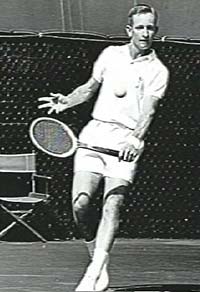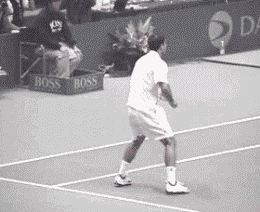
Golden Oldies:
The Slice Backhand
by Ed Atkinson
Page 2 |
Hitting the Slice
The grip should be the eastern backhand, with the wrist slightly cocked. The stance should be sideways to the net with the feet parallel at approximately shoulder width.
|
The swing is diagonal from high to low, ending with the racquet pointing toward the net. The ball should be struck as far in front of you as is comfortable. The angle of the swing varies depending upon the amount of underspin you wish to create.
A player such as Don Budge
or Ken Rosewall could drive through the ball with slice, penetrate the
court, and even, in Rosewall’s case, hit effective passing shots.
The most essential element
of the stroke is that there is no break in the wrist or forearm at
contact. Starting from the cocked position on the backswing, the racquet is thrust forward until the arm is completely straight.
Click here to view Ken Rosewall's slice backhand. |
Chip and Charge
When using the slice
approach, it is critical to remain as still as possible when contacting the
ball. Obviously to make an approach shot you must run forward toward
the short ball. A prevalent mistake is to run up to the ball
and hit without stopping. This error can be fatal. The
momentum of your body combined with the speed of the oncoming ball turns
an easy opportunity into a very difficult shot. So remember, run, plant
(your feet), and hit.
It is my belief that the
chip and charge should be used virtually every time your opponent hits a
second serve. This tactic was a staple of the great serve and volley
players like Kramer and Rod Laver, as well as many others in the golden
age of grass court tennis.
|
But the chip and charge is vastly under utilized in the modern game. Why? It is here that I must vent my spleen against what I consider the greatest disservice to men’s tennis in its history—the increasing dominance of the two-handed backhand.
Yes, the two-handed shot
allows one to hit greater crosscourt angles and is, perhaps, more
difficult to read. So much for the good news.
The bad news is that it reduces
the players’ reach, a weakness that is graphically exposed in the return
game. Worse, it keeps players from developing a natural slice backhand,
which reduces the ability to play good defense, and virtually eliminates
the ability to chip and charge or play serve and volley (See The
Golden Age of Serve and Volley, by Ed Atkinson)
If the bad news exceeds the
good so dramatically how did the two-handed backhand reach it’s present
popularity?
The answer is that children are introduced to the game at a far too early age. This phenomenon is exacerbated by the fact that present racquet construction makes racquets too heavy in the head. When an infant is required to hit a backhand drive with a head heavy racquet, the only alternative is to use two hands.
|
|
No child should commence playing tennis before the age of ten—at the earliest. There have been great champions who started playing in their teens. Once a player is strong enough to develop a one handed backhand, he can develop the serve and volley and the chip and charge tactics.
With the correct technique,
the chip (slice backhand) is safe and effective, and the tactic puts
enormous pressure on your opponent.
This pressure only increases
as the match wears on. Your opponent will attempt to hit his second
serve harder and/or deeper, engendering double faults. To hold
serve, he will be forced to hit the most difficult shot in tennis—the
passing shot—on a repeated basis.
To some this strategy may
appear extreme, yet it was the preferred tactic of the greatest champions
the game has ever seen. Use the slice backhand to create a
relentless attacking style and you too will reap the benefits of the old
adage: “Fortune favors the bold.”
 The
Kings of the Court historical video, produced by TennisONE
contributing editor, Ed Atkinson, is the ultimate legacy for the tennis
enthusiast, and a must for anyone who wants to understand the
history of the game. The
Kings of the Court historical video, produced by TennisONE
contributing editor, Ed Atkinson, is the ultimate legacy for the tennis
enthusiast, and a must for anyone who wants to understand the
history of the game.
Kings of the court presents amazing, rare, and often, never before seen footage of the greatest champions in the history, from Little Bill Johnson and Big Bill Tilden to Don Budge, Jack Kramer, Lew Hoad, Pancho Gonzales, and Rod Laver. Narrated by John Forsythe with a highly evocative original musical score, it can be purchased in the TennisONE ProShop |
For more articles in Ed Atkinson's Golden Oldies series, visit the TennisONE lesson library.
Your comments are welcome. Let us know what you about think Ed Atkinson's article by emailing us here at TennisONE.
Last Updated 2/1/02. To contact us, please email to: webmaster@tennisone.com
TennisONE is a registered trademark of TennisONE and SportsWeb ONE; Copyright 1995. All rights reserved.


